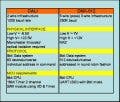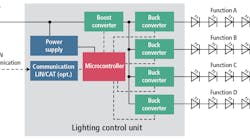One of the more exciting challenges for lighting designers is how the end-user controls the HB-LED product. Legacy lighting products such as incandescent lights are dominated with the On/Off switch, and a dimming function. Since HB-LEDs require electronic control to dynamically control current and operate the light-source (higher current leading to overheating can half the lifetime of the HB-LED), designers can look at other features to enhance their product.
These features could include control panels with keypads and slider functions to dim/change color and thus alter the mood in a room; automatic sensing of persons in a room using PIR proximity detection; or infrared remote control of lighting. Also, the simple ON/OFF switch can be enhanced using new low voltage technologies such E-field**, which can reliably and accurately sense an object approaching and determine its mass, allowing touch-less control. All these types of features will help lighting manufacturers bring HB-LED lighting products to the home.
[** E-field – is a new technology for touch control systems by generating low frequency electric fields and measuring differences measured as objects approach electrodes. See Freescale semiconductor’s MC33975 E-field sensor.]
In many cases, these types of feature will not be added directly to the HB-LED product, and will be remote from the lighting source, requiring connectivity interfacing. In the lighting market today, connectivity is dominated by two protocols: DMX-512 and DALI. This article examines these two protocols and describes how they differ from each other.
DMX512
DMX512 is a standard wired communications protocol used extensively in industrial lighting applications such as theatre stage lighting and exhibition lighting. The physical interface consists of 3 to 5 wires with 1 data signal constructed using 2 differential lines (D+,D-), a common/ground (0V) and an optional second set of Data lines.
The DMX512 system is configured as a DMX universe, which consists of 1 DMX Control node and DMX devices up to a maximum of 512. If the system requires more than 512 lights then further DMX universe(s) will be required. The DMX Control node initiates a break followed by a 1byte command, subsequent bytes are sent in order which correspond to each DMX device within the DMX universe.
The DMX Control node initiates a break followed by a 1byte command, subsequent bytes are sent in order which correspond to each DMX device within the DMX universe. As shown in Figure 5. The DMX Control sends a Break followed by a Null (00) command which tells all the DMX devices to expect a brightness level will be sent. Each DMX device needs to be aware of their DMX address 1 to 512 and counts the bytes being transmitted by the DMX control to ascertain which byte they should react to.
The SIP allows the DMX controller to understand the capabilities of the DMX device in the universe and provide the user the correct control features to get maximum performance.
DALI
Bi-phase decoding is accomplished with the following: a logical zero consist of sending a physical low signal for 416 µs immediately followed with a physical high signal for 416 µs. A logical one consists of sending firstly a physical high signal for 416 µs followed by a physical low signal. A physical high signal on the DALI Data line is a voltage level between +9.5V and +22.5V. A physical low signal on the DALI Data line is a voltage level between -6.5V and +6.5V (see Figure7.)
DALI vs DMX
When choosing between DALI or DMX512, the lighting engineer needs to address the points shown in Figure 10.
Having a slower data rate, DALI can update one lighting source in approximately 16 ms, resulting in a full 63-device system would take just over 1second. DALI is targeted at household applications where there is no expectation to change the mood of the lighting every few seconds, as in a stage or show environment.
In terms of the cost of the communication infrastructure, DMX512 can be implemented as a 3-wire interface: GND, D+ & D- , using a Universal Asynchronous Receiver Transmitter (UART) and a level shifter. UARTs are a common feature included with microcontrollers, and EIA 485-A level shift ICs are readily available. (Check that the UART feature can support 8bit with parity, otherwise software will need to be developed to produce the 2nd STOP bit.)
DALI is implemented as a 2-wire interface: Power and Bus. Due to the fact that DALI utilizes a Bi-phase decoding technique this consequently requires a modified UART type feature (standard UARTs work with Non Return to Zero (NRZ) formats) which are not so commonly available on microcontrollers today.
However, with DALI’s low speed of 1200 baud it can easily be implemented with software on an embedded microcontroller utilizing a timer function to ensure synchronization is kept. One cautionary note is the DALI specification as declared in IEC 60929 also requires that all DALI devices are galvanically isolated from the mains power supply which results in adding optical isolation.
Summary
With HB-LED lighting requiring the use of low-voltage electronic control, low-cost microcontrollers will help in bringing additional compelling features to household lighting.
Microcontrollers make it easier for lighting designers to incorporate a reliable connectivity interface such as DALI and DMX512 that will provide the backbone for adding remote user controls.
References
BS EN 60929:2004 A.C.-supplied electronic ballasts for tubular fluorescent – Performance Requirements
American National Standard E1/11 2004 / USITT DMX512-A Asynchronous Serial Digital Data Transmission Standard for Controlling Lighting Equipment and Accessories
Freescale Semiconductor - AN1985 Touch Panel Applications Using the MC33794 E-Field IC















